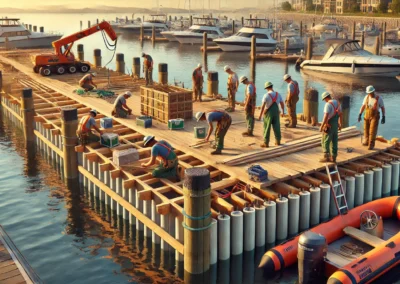Repairing soft spots on boat decking can be a complex and challenging task for several reasons. Here are some of the biggest challenges people face when undertaking this repair:
1. Identifying the Extent of the Damage
- Hidden Damage: Soft spots often indicate underlying issues such as rot, water intrusion, or delamination. The visible soft spot might be just a small part of a larger problem that extends beneath the surface.
- Diagnosing Cause: Determining whether the damage is due to water intrusion, improper installation, or material fatigue can be difficult, especially for those without experience.
2. Accessing the Damaged Area
- Structural Complexity: Boat decks are often part of a complex structure that may include layers of fiberglass, wood, and core materials like balsa or foam. Accessing and removing the damaged layers without causing further damage can be challenging.
- Confined Spaces: Working in tight or confined areas, such as below decks or near bulkheads, can make repairs more physically demanding.
3. Material Compatibility and Selection
- Choosing the Right Materials: Selecting the correct materials for repair (e.g., fiberglass, resins, core material) that are compatible with the existing deck can be tricky. Using incompatible materials can lead to further problems.
- Matching the Original Finish: Achieving a seamless repair that matches the original deck’s appearance, texture, and color can be difficult, particularly with older boats where the deck may have weathered over time.
Find a deck repair pro near you today to help you!
4. Proper Technique
- Skill Requirements: Properly repairing a soft spot requires a solid understanding of boat construction and repair techniques. Without experience, there’s a risk of improperly mixing resins, incorrectly laying fiberglass, or not properly sealing the repair, leading to further issues down the line.
- Waterproofing: Ensuring that the repaired area is fully sealed and waterproof is crucial to prevent future water intrusion and recurrence of soft spots.
5. Time and Cost
- Labor Intensive: Repairing soft spots is often a time-consuming process that requires patience and precision. Rushing through the job can result in subpar repairs.
- Expense: The cost of materials and possibly specialized tools can add up, particularly if multiple areas need repair or if professional help is required.
6. Safety Concerns
- Working with Hazardous Materials: Fiberglass, resins, and other repair materials can be hazardous if not handled properly. Adequate ventilation, protective gear, and careful handling are necessary to avoid health risks.
- Structural Integrity: Ensuring that the repaired area restores the structural integrity of the deck is essential. Poor repairs can lead to safety hazards, especially in high-stress areas of the boat.
7. Environmental Factors
- Weather Conditions: Repairs often need to be done in dry conditions, which can be challenging if working outdoors. Moisture in the air or on the boat can affect the curing process of resins and adhesives.
- Temperature Sensitivity: Many repair materials are sensitive to temperature, requiring specific conditions for proper curing. Working in too cold or too hot conditions can compromise the repair quality.
These challenges highlight why repairing soft spots on a boat deck is often a task best suited for experienced DIYers or professionals with the necessary skills and tools.





